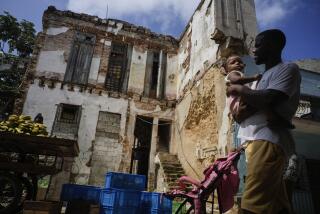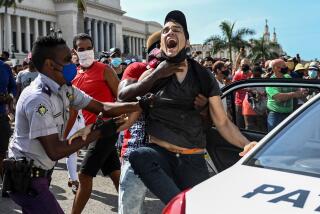The Other Caribbean : Unspoiled Beaches, ‘50s Cars and Pre-Glasnost Politics Keep Fidel Castro’s Island Locked in a Time Capsule
HAVANA — Driving toward the fertile Cuban countryside and the tranquil beaches east of Havana, cars squeeze through a pre-revolution toll booth. The fare collectors lost their jobs in 1959, dispatched with the cry: “The highways are for the people!” And yet the forsaken toll booth remains, fouling modern-day traffic like a spectral speed bump.
All of Cuba’s clocks seem to have stopped three decades ago. While much of the rest of the Communist world celebrates McDonald’s fries and glasnost, Cuba and its 10 million residents remain stuck on pre- perestroika time.
But if this is one of the last citadels of traditional Marxism-Leninism, it is also, thankfully, one of the Caribbean’s most unspoiled islands. It’s not difficult to imagine why in 1492 Christopher Columbus remarked: “This is the most beautiful land man has ever set eyes on.”
Developers are storming through nearby resort islands with high-rise hotel plans in their satchels, but Cuba remains firmly in the idyllic ‘50s.
As North Americans steer back to crew cuts, classic cars and picnics, Cuba is already there, locked into the carefree tropical life style that once made this alligator-shaped isle the definitive post-World War II getaway. This is a living, breathing time capsule.
Fly for just 45 minutes from Miami International and you’ll discover a world frozen 30 years in the past, operating on a very different form of government.
The stage is set even before you land at Jose Marti International Airport, named after the 19th-Century Cuban writer and revolutionary. Before you land on the Tarmac, you can see huge neon letters beckoning below: “The first duty is work.” It’s one of many signs urging loyalty to the party and its teachings.
I had come to Havana, among other reasons, to take a look at the new productions of Cuban film students and the cinematic offerings of the rest of Latin America, examine the handiwork of “maximum leader” Fidel Castro, and maybe catch a baseball game or two.
As part of a delegation attending the Havana Film Festival last December, I avoided a U.S. trade and tourist embargo that for now keeps most Americans (but not all--see accompanying sidebar) away from what was once the United States’ original sin city.
To appreciate the solid soul under Cuba’s crumbling facade, it’s essential to set aside stereotypes, take a deep breath of the invigorating air and reopen your eyes. Few people here chomp cigars and Ricky Ricardo is nowhere to be seen.
Yet everywhere you look, most every step you take, you’re reminded of differences, both subtle and profound, between the glamorous, upscale, tourist-soaked Caribbean of Barbados, the Bahamas and St. Croix, and Cuba’s humble, uncalculated lifestyle.
There are beautiful, undeveloped beaches and there is quirky, interesting architecture, both grand colonial and ersatz plantation. Churches are baroque, positively European. Classic cars are preserved with meticulous care and frequent waxings. Although spare parts are almost impossible to come by, automotive maintenance is an art form.
At the same time, you see the hallmarks of communism everywhere: The local newspaper, when not bashing the Yanquis, puts a utopian spin on almost every crisis of socialism. Havana, with its dilapidated “modern” skyscrapers and inescapable bureaucracy, moves in slowest motion when you need it to move fast. At almost every corner in the city, locals wait in line--for buses, groceries or a drink.
Wandering around Havana, chances are favorable that you’ll come across a huge portrait of Che Guevara, plastered on the side of some building.
Alongside the highways, teeming with the speeding Soviet-made Lada taxis, are signs reading: “Socialism or death!” The Museum of the Revolution in the center of old Havana is filled with arresting relics from Castro’s rise to power against the Batista dictatorship--the bullet-riddled “Fast Delivery” truck used to seize the palace, the yacht Granma that brought Castro and his colleagues to shore and assorted tools of the military.
On occasion the system unexpectedly clicks. At Havana’s hotel Capri, a Holiday Inn-like structure with a pool on the roof where the barbecue is always busy and the bar rarely deserted, I arranged for a daylong trip to Varadero beach on the official Cubatur bus.
“What time does it leave?” I asked in Spanish of the Cubatur representative in the lobby. “At 8:30 in the morning,” she replied. “8:30 sharp?” I asked. She laughed. “Oh no,” she said. “Nothing in this country happens sharp.”
The next morning I grabbed my day pack and bounded into the lobby at 8:31. The bus had already left. So much for tradition.
These days, the government is promoting tourism actively, most of the major hotels have been refurbished in the past few years, and Havana’s historic streets consequently are filled with Canadians, Eastern Europeans, English, French and even a Russian or two.
While the country has lost some of those unique features that drew thousands in the middle of this century--alcohol during Prohibition, gambling and prostitution--the tourism department is trying to re-establish Cuba as a vacationer’s destination. The place may still look in spots like a bad sound stage version of old Miami, but who else has top-of-the-line Cohiba cigars for three bucks apiece?
If you can survive a night in Motel 6, you’ll probably make it in Havana’s lodgings. They’re never dull.
Things you’d never worry about failing don’t work. Hotel soap--cheerfully emblazoned “Your friend in Cuba”--doesn’t lather. The Capri does have a George Raft suite in the penthouse, dedicated to the late actor (who was a frequent visitor) during Havana’s prime.
The top hotels, the Nacional, Capri and Havana Libre, are all within a mile or so of one another, are all government-owned and are pretty much interchangeable.
The Libre, formerly a Hilton, looks the most like a modern tourist hotel. The rooms bear a shadow of their former splendor. It’s easy to imagine an earlier generation sitting on the rooms’ expansive patios, cocktails in hand, beaming at the racy, bustling city below.
The Libre still has an excellent array of shops in its lobby, including a top cigar store. It has a respectable theme restaurant serving pretty good fresh fish, and at night the park across the street is filled with friendly teen-agers snacking at Coppelia, an open-air ice cream stand. Cones are a dollar, and over a scoop of strawberry, we chatted with a Nicaraguan soccer player in town for a tournament.
The Nacional, which was undergoing extensive renovations last winter, could emerge as the city’s premier hotel if the remodeling is skillfully executed.
An imposing Spanish-themed building, the Nacional has wonderful views of the harbor and reminds you of the elegant European style that distinguished Havana in its prime. The hotel also has a well-maintained clay tennis court.
From any of these hotels you can set out on foot along the Malecon, a wide promenade that winds lazily to the northeast along the Gulf of Mexico toward the city’s oldest neighborhoods.
Along the Malecon, where waves occasionally crash over the retaining wall, fishermen cast lines, reeling in their filament around aluminum soda cans, and young boys bother the strangers going for a stroll. Money exchange rates are very good with these kids, but don’t be tempted: it’s against the law.
A stroll takes you past typical Cuban homes, formerly regal, now a bit threadbare: the beautiful paint jobs are down to their last few flakes, and the day’s laundry flaps in the gentle sea breeze.
Across the channel, to the north, is a lighthouse and Castillo del Morro, built at the end of the 16th Century. The castle is open to the public, and in front of it is the Battery of the 12 Apostles, with each gun bearing an apostle’s name. Also across the channel is Fortaleza de la Cabana, a sprawling fort-like structure where prisoners were shot during Cuba’s fight for independence.
Other points of interest in old Havana: the Plaza de la Cathedral, where an open-air market featuring local handicrafts, vegetables, books, music and clothing is held on weekends; the nicely landscaped Parque Central, a popular hangout for the well-attired Communist youth; the Teatro Garcia Lorca, where the National Ballet of Cuba performs; and the Capitol building, which bears an eerie resemblance to the one in Washington.
Anti-American party politics are hurled at tourists wherever they go, but there are some ironies. A taxi driver, asked if anyone listens to the U.S. propaganda channel Radio Marti, quickly punches a preset on his dashboard and there it is.
One of my guides spoke at length about U.S. propaganda and the glories of communism as we toured the countryside of sugar cane, orange groves and a graduate film school. At lunch at the school, when the cafeteria line was stalled by a plate shortage, the guide suddenly started grumbling. “This is the problem here,” he complained bitterly. “No service.”
By the time we returned to Havana a few hours later, he seemed ready to ask me to smuggle him to Miami in my garment bag. Others appear to relish American culture: One local movie house was showing “Howard the Duck.”
Cubans will tell you, too, that there’s no crime here. I told one Cuban journalist that this wasn’t exactly true.
The previous night, the wife of writer Normal Mailer, in Havana for the film festival, had been accosted. The journalist looked confused for a second. “Yes, but at what time was she robbed?” he asked nonsensically; I’m still not sure what his point was.
Wandering around Havana, a few dozen locals might join your stroll, asking whether you wouldn’t mind donating your new sneakers to their wardrobe.
If Havana is a little unnerving, just outside the city parts of the countryside resemble a Caribbean cloudland. At Santa Maria del Mar, a few minutes outside of Havana, a man flailed happily on a capsized sail board in the clear, warm water.
Reclining on the perfectly clean white sand, it’s easy to believe you’re visiting Club Med in some parallel universe. (Several weeks later, an unhappy camper windsurfed from Cuba to Florida; I wonder if it was the same guy.)
Dancing into the night at a local salsa stand on the outskirts of Havana, sipping a rum-laced mint julep called a mojito, literally, “a little wet one,” it doesn’t really matter that breakfast the next day again will be watery scrambled eggs and lukewarm tea, or that most of the country hasn’t been painted since the Cuban Missile Crisis.
And where else can you find a guided tour of the Bay of Pigs, the infamous 1961 invasion site? (An overnight trip arranged by the government tourist agency Cubatur to Playa Giron, as the Bay of Pigs is called, and nearby cities costs $55, including one night’s hotel and meals.)
Or visits to the perfectly preserved home of Ernest Hemingway? A $20 ride in a tourist taxi from Havana, the Hemingway house is a former Spanish Army lookout crammed with the writer’s books, hunting trophies and furniture. It’s just as Papa left it in 1960. And, back in downtown Havana, you can swing by La Bodeguita del Medio, as Hemingway did regularly, for a drink.
The museum of Guanabacoa, another brief ride from the nation’s capital, holds an array of exhibits documenting the Santeria religion and its musical, animistic and voodoo influences. Admission to just about everything--including baseball games--is free.
Varadero Beach, set on a long peninsula, is the country’s most important (and most developed) beach resort, and seven new hotels are planned there.
Of the 4,500 miles of Cuban coastline, this stretch has been selected as Cuba’s Cancun. The Cubatur trip there (that’s the bus I missed) costs $33 with lunch or a few dollars less without the pre-paid meal, and lasts from 8:30 a.m. to around 5 p.m.
It’s considered Cuba’s most touristy stop, and bears a strong resemblance to a narrow spit of land on the Bahamas. Restaurants there include Las Americas (specializing in Cuban seafood), Albacoro and the Italian-oriented Castel Nuovo. At night, Varadero’s Pirate’s Cave is the hot club.
If you’re not fond of the Cubatur buses (they’re air-conditioned, and usually filled with a fascinating array of Eastern European tourists), you can rent a car. There’s an agency adjacent to the Capri but reservations need to be made in advance as cars are scarce.
The more adventurous can travel to Santiago, the country’s former capital. Located on the southeastern tip of the island, Santiago is adjacent to the Guantanamo U.S. Naval Base (somehow it’s still in operation, and frequently criticized in the Cuban newspaper Granma).
Trips to Santiago leave every Tuesday from the airport, and it’s a great deal. For $89, you receive round-trip air fare, all transfers, cocktails and lunch.
The tour includes visits to the home (built in 1519) of Conquistador Diego Velazquez, the Piracy Museum, the Moncada Garrison--where Castro attacked in 1953 to launch the revolution--and the Santa Ifigenia cemetery, where national hero Jose Marti is buried. The trip leaves the airport at 7:30 a.m., returns at 5 p.m.
During the film festival especially and at other times in the year, Cuban nightclubs play jazz until the early morning hours.
Ask a tourist taxi driver for a recommendation, or play it relatively safe and go to the Tropicana. The Tropicana, one of the more anachronistic relics from Havana’s heyday, is in its 51st year of operation.
Patterned after a Las Vegas casino show, the legendary floor program sees scores of dancers undergo dozens of costume changes over the course of several hours. It’s a weird sight, distinctly Cuban, but somehow not quite right.
Cubatur has a desk in most of the major hotels, including the Capri, the Havana Libre and the Nacional.
Superior food and drink in Havana is hard to find, but recommended restaurants include Floridita (good daiquiris), La Bodeguita del Medio (with roast suckling pig) and Las Ruinas (considered the most elegant place in town). Other respected establishments are La Torre, El Patio and El Conejito.
Shopping opportunities are limited, and you can only bring back $100 worth of merchandise to the States, but there are a few antique and folk art stores, selling hand-dyed fabrics at reasonable prices, a few pieces of pottery and various tacky souvenirs. (Empresa Fondo Cubano Bienes Culturales is worthwhile, with an upstairs full of fabrics and a downstairs with a few acceptable pieces of folk art.)
And don’t let annoyances like the abandoned toll booth get you down. It’s just part of the scenery.
More to Read
Sign up for Essential California
The most important California stories and recommendations in your inbox every morning.
You may occasionally receive promotional content from the Los Angeles Times.











